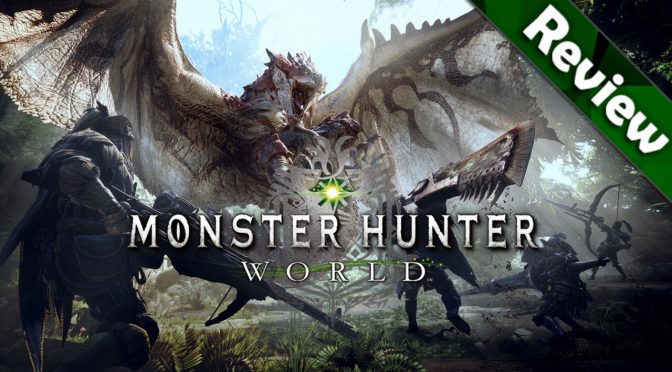I’ve always wanted to play a Monster Hunter game, so naturally when I heard Monster Hunter World was coming to the PC I was super excited; both as a PC gamer and someone who has always been curious about the series. In fact after seeing the positive reception on consoles, the game was quickly becoming one of my most anticipated titles of 2018.
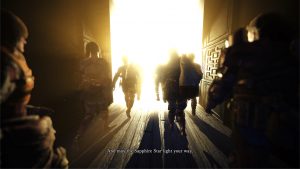
The PC version was delayed by 7 months to be tailored for the platform. Like many others I waited and hoped that we would get a good PC version. The question is, did we?
After playing the game for over 100 hours, finishing the campaign, and of course spending time with all the side activities, I’m ready to share my thoughts on the experience.
The current state of the game:
The first thing I want to talk about is the current state of the PC version, since I know that the quality of the port is going to be an important factor to many who are still on the fence as to whether or not they’re going to purchase the game.
Monster Hunter World launched with a number of problems, but there have been three patches since launch that have fixed some of these. The connectivity issues have been fixed as have the mouse control problems, which is a godsend if you’re planning on using the mouse.
Unfortunately performance is still not as good as it could be. While it’s not the worst port performance I’ve seen ( Arkham Knight, GTA 4 and Saints Row 2 come to mind), the performance is certainly worse than it should be on capable hardware, based on the game’s visual fidelity, and there were times when it never felt smooth even when the frame rate was high.
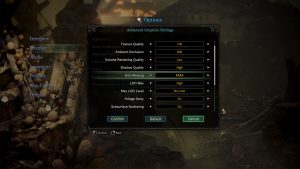
I had to run with some settings turned down (most notably Volume Rendering Quality on low or off), but even then there were still occasions where the frame rate dropped into the low 60’s or below during especially busy sequences. It’s better than it was at launch, but the game still needs more optimization.
The other problem that is still present are textures that don’t load in correctly. As a direct result they look incredibly blurry compared to the console versions, even at the highest setting. Reflections are also still missing , which is demonstrated in the Digital Foundry’s Youtube video.
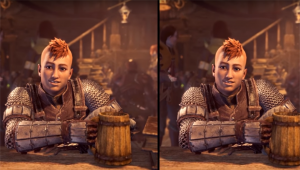
What is a little concerning is Capcom’s silence on these problems. While I don’t expect overnight fixes or miracles, it has been over a month, and I do think that they should be more communicative with the community regarding these issues.
They said they delayed the PC launch so that they could bring PC users a “great optimized experience“, unfortunately its seems they still have some work to do.
The Story:
The story of MHW revolves around tracking an elder dragon by the name of Zora Magdaros, that has made it’s way into the new world. You’re part of the 5th fleet and need to find out why it’s there and what is causing the strange behavior of the creatures that live there.
The story is average, the voice acting mediocre and the lip syncing is possibility the worst I’ve ever seen even when set to Japanese voice overs. Despite that I don’t want to tread into spoiler territory, because even with its flaws, the story is still part of the MHW experience and does a decent enough job of introducing new characters, new monsters, new mechanics, and new areas to the player.
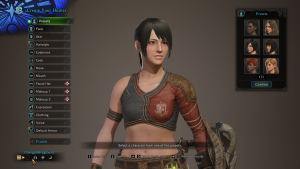
You get to create and customize your character and your cat companion (called a Palico) at the start of the game. It’s not the most robust character creation around, but there are enough options to fiddle with that will allow most people to create an avatar they’re happy with.
After a somewhat lengthy tutorial you’ll arrive at the main hub area, talk to a few NPCs and be given a quest to investigate a monster problem in the Ancient Forest. You’ll also be introduced to the training area where you can practice and try out any of the 14 weapons that are available, and then be sent on your way.
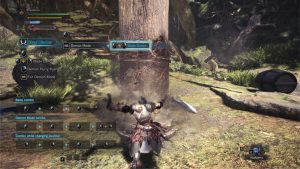
The World:
The game is divided into 5 separate biomes in addition to the two hub areas. It’s not an open world per se, but each biome is a large well designed set piece that’s an absolute joy to explore, full of collectibles such as herbs, mushrooms, bugs and wildlife, making it feel like a living breathing eco system.
The zones themselves are actually quite complex, with shortcuts, places to climb, swing, slide and even fish. There is also day/night cycle which add a lot of atmosphere.
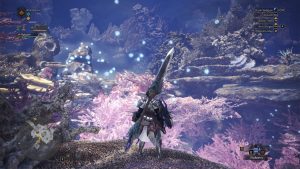
In a typical session you’ll either be exploring one of these zones via expeditions (which is essentially a free roam mode) or going on hunts (timed missions to kill or capture one or more monsters). Each biome is home to specific monsters, which ones they are will depend on whether you playing in Low or High Rank mode.
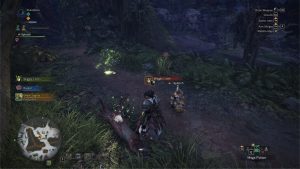
In addition to collecting resources, you’ll also be investigating various monster trails which not only allow you to track a monsters movement in that zone, but also level up your knowledge of that respective monster, which will provide you with more detailed information about it (strengths, weakness, resistances and what it drops for example) as well as unlocking investigations missions.
Hunts can also be interrupted by the other large monsters that are wandering around in each zone and this can complicate things since they tend to do so at the worse possible times. They’ll fight each other which is a site to behold, possibly giving you an advantage, or just try to kill you. Thankfully it’s possible to chase the unwanted guests away by firing dung at them if things get out of hand. The interaction between these behemoths is another aspect which make the world more believable.
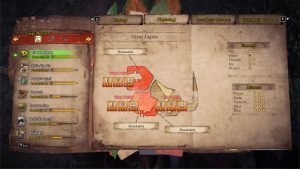
Combat:
When I first heard of Monster Hunter World I was worried that the monsters may end up feeling gamey, like most video game bosses and being an exercise of trial and error where you just have to learn the patterns by dying numerous times. This is not the case at all with MHW. These bosses behave like believable creatures. If they have horns they’ll ram you, if the tail has spikes they’ll probably try and hit you with it, if it has huge teeth it’s take going to try and take a bite out of you. That’s not to say that each monsters doesn’t have patterns, of course they do, but it’s done well and doesn’t feel out of place as a result.
My encounter with the first monster was a great experience. It was a tense back and forth battle, striking where I could with my dual blades, dodging attacks, leaping off high ledges to mount and strike the beast from above with the beast trying desperately to shake me off by ramming into the environment. After a grueling battle, the beast retreated with a limp, me giving chase, leading to the final confrontation where I was able to down and scavenge it for parts that I could use to craft a better set of armor. It felt like a hard earned victory, a genuine battle and it was very rewarding.
As the game progresses, the monsters get larger, stronger and more complex, but that sense of awe, the feeling that I was hunting a real and dangerous creature continued throughout the game and never let up. The difficulty increased at a steady rate, requiring me to be better equipped and prepared for each successive hunt, but I never felt that it was unfairly difficult, and if I died it was almost always due to mistakes I made.
I don’t want to talk about the monsters you’ll fight, or their mechanics, since I believe that the sense of the unknown you have when encountering these creatures for the first time is is a big part of the experience. I’d also recommend that you don’t watch guides, or play those encounters with others until you’ve defeated the monsters yourself (if you want to get the most from the experience). What I will say though, is that there are plenty of monsters to hunt (35 at the moment, not counting the more powerful versions of some of the monsters), each of which provide a very different battle.
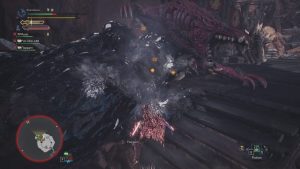
The combat in MHW is more tactical than I expected. At first it may seem clunky or slow, especially with the heavier weapons, but it’s all about timing, positioning and stamina management.
You need to know the speed of your strikes, when to start the next move in your combo, if you should start the next move in your combo, how long your combos take to finish, which is the best combo to do based on your current position and of course you need to know your enemy.
Moves cannot be cancelled mid animation, so you can only dodge once a move it’s finished. Some weapons don’t even allow a dodge.
Button mashing will only get you killed, as will running out of stamina, especially later in the game. There is a lot you need be concentrating on in each battle, and the battles themselves can last upward of 20 minutes, requiring you to stay focused and make sure you’re equipped enough to last for the duration.
There is a high skill ceiling with the combat, and as a result can be incredibly satisfying when you master it.
Weapons:
Each weapon requires its own mastery. They all have different combos, timing, mechanics and ranges. Switching to another weapon can, in some cases, almost feel like an entirely different game.
In addition to them playing completely differently there are variations to each of these weapons, and while their combos may remain the same, each variation adds different elemental damage and also has upgrade trees (in some cases more than one) which add to the build diversity you can choose to use.
Dual Blades for example are incredibly fast, but require that you be very close. Enabling demon mode builds up your Arch demon meter while consuming stamina constantly, but it allows you to do extremely fast attacks. Arch demon mode on the other hand is a hybrid between normal and demon modes, where LMB will do normal attacks and RMB will do the more powerful Arch Demon attacks. You’re constantly jumping between the two modes in combat and managing their respective meters to do as much damage as possible.
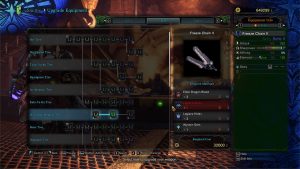
The Insect Glaive is slower but has longer reach and excels at airborne attacks. This weapons mechanic focuses around an insect that you shoot at the monster and depending on where it hits, will return a damage buff or a speed buff for example. You stack all these buffs at the beginning of the fight then proceed to battle the creature, gliding through the air doing combos and mounting the monster where possible. The playstyles of these two weapons are completely different from one another but are both absolutely viable.
There is more to these two weapons than I have covered here, but my point is that there are twelve other weapons that also have their unique mechanics, so even though you maybe fighting a monster you’ve fought numerous times before, using a different weapon changes the encounter dramatically.
All the weapons have the sense of impact you’d expect them to have based on their weight. Slow weapons feel heavy and hit hard, whereas faster weapons allow you to gracefully maneuver around your target.
Once you reach High Rank mode you can also upgrade weapons to have sockets which take decorations (gems with skills) that allow you to further customize your build.
In addition to this, when you reach end game, you can augment weapons with Streamstones which can be used to upgrade the various stats on each weapon, if you’re willing to grind for them of course.
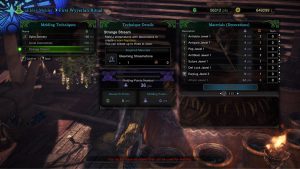
Armor:
Armor is a big part of MHW and you’ll be constantly changing and upgrading your armor throughout the game. Each piece of armor provides defense, resistances to the various elements in the game (Fire, Ice, Thunder, Water and Dragon), as well as skills. There are over 100 different skills associated with armor/decorations that have varying maximum levels.
Skills come with different benefits, they can increase resistance to certain elements, make poison more effective, improve the chances of successfully mounting monsters, add the ability to consume consumables faster or use less stamina when dodging for example. Some of these skills only have 1 level, whereas others have several levels. The more of a particular skill you have equipped across your armor and sockets the higher it’s level will be and as a direct result the more effective that skill will be.
In addition to this, every main monster in the game provides it’s own full 5 piece set of armor, with some of the smaller wildlife providing only particular pieces. Having a few parts of a set (the number depends on the set) gives you an additional skill specific to that set.
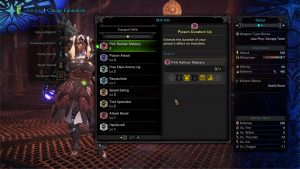
Armor comes in two categories:
Low Rank
These are the armor sets you’ll be using for the first part of the game. Each piece provides only one skill (zero in some cases, like the leather set where only the helmet offers a skill) and only one level of that skill, along with defense and resistances.
High Rank
These are the armor sets you’ll gain access to once you unlock High Rank mode partway through the campaign. These armors are better versions of the low rank armors with higher defense values, there are also a plethora of new armors unlocked in this mode. High Rank armors come in two variations per set: Alpha and Beta.
The Alpha set typically has two level one skills attached to it , with some armors having one level two skill.
The Beta sets on the other hand only have one level one skill, but have a socket instead of the additional level/skill, which give you the option to choose what decoration (gem) you put into that socket, essentially allowing you to choose what the second skill will be. Rarer weapons & armor have more than one socket (Up to 3).
So it’s through your choice of armor, weapons and decorations that you determine your build, and once you reach High Rank mode the customizability of your build changes quite dramatically.
In addition to all of this armor can be upgraded to increase it’s defense value with armor upgrade orbs of varying rarity (which you get as quest rewards). Each armor piece has a limited amount of upgrades it can receive, but you can augment armor with Streamstones to remove these limitations entirely when you reach the endgame.
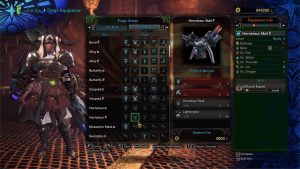
Once you’ve gotten different armor sets setup you can save each equipment loadout for quick access depending on what you are hunting. It’s a great feature, but I never found myself using it since my build was adequate enough to get me through the campaign, and hunt whatever I needed without any issues. (Including killing several tempered bosses). There are over 100 slots available, which seems like overkill, but they’re there if you need them.
The Palico:
Your cat companion known as a Palico is not just there for the cuteness factor, it’s actually a valuable addition to your team, especially if you’re playing solo or duo. I’ve lost count of the amount of times my Palico saved me with a heal or drawn aggro just when I needed a moment to recompose myself during a difficult battle.
The Palico itself can also be outfitted with armor and weapons much like your own character, but it’s armor only adds defense and resistance, not skills like they do with the characters armor.
However, your Palico has the ability to use gadgets. There are a total of 6 gadgets that can be unlocked if you do the respective quests in each biome, and each gadget can level up to improve it’s efficiency.
One of them has your Palico throwing bombs, another stealing items from the monsters, another places a trap that acts like a flashbomb, but none of the gadgets were quite as useful as the Vigorwasp spray (a healing gadget) which your Palico starts with, except maybe Coral orchestra which has your Palico play music that gives you offensive and defensive buffs. Nonetheless, it’s nice to have a choice of gadgets that may compliment your build or playstyle.
You can also tell your Palico to stay behind when going on hunts if you want the extra challenge. It’s just a pity that you can’t set it’s behavior parameters, since everything else in the game is so customizable.
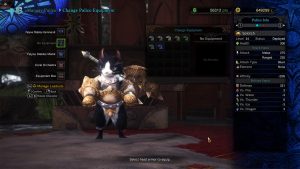
Missions:
There are a number of mission types you can choose from in MHW.
Assignments are the main missions that push the story forward.
Optional quests are the side missions, given by various NPCs that will add new food types to the chef menu or upgrade the various facilities that unlock during the campaign like the botanist for example, where you can actually grow your own ingredients for crafting various potions.
Investigations are quests that are unlocked by tracking footprints in each zone. These are hunt/capture missions where you’ll have to hunt/capture a single or group of monsters for a reward.
Events are quests that offer bonus rewards if completed, but are only available/active at certain times.
Finally Expeditions, which are not missions exactly, but rather a free roam mode where you can just go and explore any biome without time constraints, but still have the opportunity to hunt the monsters that reside there.
There are also Bounties that can be selected. They are not missions either, but reward you for completing various goals. (For example finishing X amount of quests in a X biome, or killing X amount of large monsters etc).
Every mission has a HR (Hero rank) associated with it. So naturally the higher your HR the more difficult missions you’ll have access to (with better rewards), and by the same token there will be certain missions you’ll be unable to take until you have the appropriate level.
All of these missions can be played both SOLO and COOP.
The Pre-Hunt
The preparation for each of these missions is the same.
The first thing is making sure your consumables are restocked by clicking the convenient restock button. If not you’ll need to make sure to craft these item in the crafting menu.
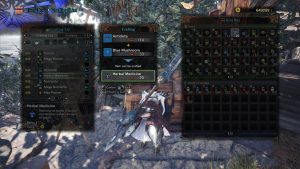
As with equipment, you can customize as as many inventory sets as you’d like for different situations. For example traps and tranquilizer bombs if you plan on capturing a Monster instead of killing it (which incidentally rewards you with more parts).
Once you’re set to go you either head up to the canteen in the hub, or eat at the base camp canteens when you arrive in the zones.
Food is an important part of any hunt. There are different ingredient types (Meat, Fish, Vegetables and Booze), each of which have 6 different color categories, and depending on the combination will infer certain food skills as well as health and stamina buffs to you and your Palico.
There are a number of preset dishes available to use, and favorite if you use them often, but you can also create and save a number of your own custom dishes tailored to your build, the food skills you want activated or the monsters you’re fighting.
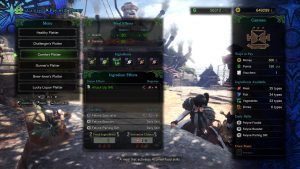
The Hunt
Once you’re all prepared it’s time to go hunting. Aside from the expeditions, all other missions are timed and have faint limits.
Times limits can vary anywhere from 15 – 50 minutes, and the faint limit (number of attempts) between 1-3 depending on the difficulty (from what I’ve seen).
The faint limit can be particularity challenging when playing with a team, because the limit does not change based on how many players there are, but the monsters health scales. So it’s entirely possible for one of your teammates to effectively fail the mission for everyone by getting downed 3 times. The more difficult mission often only allow 1 faint, so there is no room for error.
The time limit on the other hand is only really an issue if you are not geared well enough or are dealing with a particularly difficult fight.
High Rank & Endgame:
At a certain point in the story you’ll unlock High Rank mode, where new armor sets and weapon variations will become available as I touched on earlier. Once you unlock this mode you’ll have the option to load into each biome in either High or Low Rank mode, or do quests which fall into one of the two categories. This determines what monsters you’ll encounter and how hard they’ll be
In High Rank mode the monsters are stronger versions of the ones in Low Rank mode, but there will also be a few new monsters thrown into the mix as well. In general these monsters will have more heath and do more damage, but will also drop High rank parts that are used for crafting High Rank armor, weapons and decorations (Gems with skills).
Once I unlocked High Rank mode there really didn’t seem to be any reason for me to go back to Low Rank mode though.
As you progress further into the end game even more powerful tempered versions of some of the stronger monsters will appear providing you with even more of a challenge and better loot.
Many say that finishing the campaign is really where the game starts and in some ways I can see why – if you have the time of course.
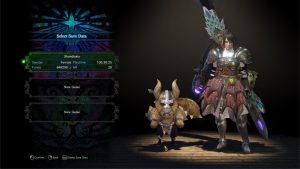
Towards the end of the campaign a few additional NPCs are unlocked at the hub.
The Pirate Captain where you can spend points to buy stuff, the ability to send out Palico teams to get resources (although neither of these seemed very useful since you amass so many resources anyway).
The Melder allows you to meld items or decorations together to into other items or decorations (The item part of the melder seemed useless as well for the reasons mention above, but the ability to craft decorations is welcome).
The Botanist, which I touched on before, allows you to cultivate your own herbs mushrooms and bugs.
However, I never played much into the end game admittedly, I only reached HR 30, but noticed that once I finished the campaign (which will probably take around 40-50 hours if you don’t do lots of side activities like I did), and killed a few tempered monsters my enthusiasm started to wane.
The end game is all about fighting stronger versions of monsters you’ve already fought, and some new monsters, to farm the parts you need for the end game weapons and armor. There is certainly a difficulty increase along the way but also an increase in the grind which some may find to be little too much.
I’d consider myself a serious gamer, but would probably be considered a casual player in terms of MHW, and not because of the games increase in difficulty, but rather because I just don’t have the time required to invest in the end game experience, at least not at the moment.
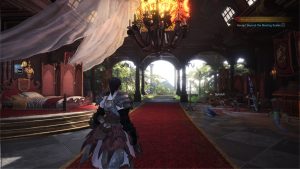
I played through the entire campaign solo, but for me the end game is where I wanted to play coop. I think that playing coop would make it more enjoyable because it lessens the tedium of the grind in addition to speeding up the process grinding (sometimes). Unfortunately no one I know plays MHW, and while playing with random group works, it also comes with it’s own issues and is not quite the same as playing with a group of friends.
Criticisms:
There really aren’t too many complaints I have about MHW, but there are a few that I want to talk about.
Playing online can be frustrating at times, when you’re quite far into an encounter and the host just decides it’s time to leave for whatever reason, and the mission just ends, or one of your teammate burns through all your faints then leaves, and as a direct result the mission fails. Situations like this make you feel like you’ve just wasted your time. It didn’t happen frequently enough to dissuade me from playing online entirely, but it did happen enough to make me wonder if I should just wait until some friends pick up the game before playing coop.
There were also times when the camera would end up in awkward positions, especially when close up to the monsters making it hard to see what was going on in some situations. the issue was less with weapons that allowed me to keep more of a distance, and it wasn’t really an issue when using the bow.
The biggest issue for me though was the UI. It’s so convoluted and unintuititve, making simple things turn into a slog of multiple key presses. It’s confusing, and clearly not designed with mouse and keyboard in mind. You’ll eventually you get used to it, but it should’ve been far more streamlined for the platform.
If you’re using a gamepad it’s better, but then it feels cumbersome because navigating complex, layered menus with a game pad is well….cumbersome.
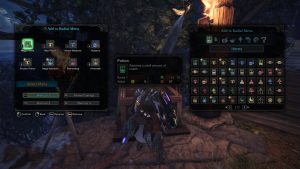
One of the reasons I chose to use mouse & keyboard was the hotkeys. The problem is in order to access these “hotkeys”, you need to first press F1-F4 to call up an overlay, only after that can you access numbered hotkeys (numbers 1-8). To make matters worse, none of the hotkey bindings can be customized.
I actually ended up making macros with my mouse/keyboard to access 2 of the 4 menus hotkeys quickly (16 buttons). A player shouldn’t have to make macros to make “hotkeys” behave like actual shortcuts. I hope Capcom address this, but it’s very unlikely.
Conclusion
There really is a staggering amount of content on offer here if you have the patience and the time to get into it, and of course if you can get past the technical issues I spoke about earlier. Some may find the game repetitive due to its grindy nature, while others may love it for that same reason. If you’re approaching the game for the story, you’re probably going to be disappointed. If you are only interested in the campaign there’s about 50 hours of game here, if you love grinding and tricking out your character with the best armor and weapons the game offers, you’ll probably find a lot to like about the end game in MHW.
I enjoyed almost every aspect of it, and despite the technical failings of the PC version of Monster Hunter World, it wasn’t enough to prevent me from enjoying the game immensely. They are certainly not bad enough to prevent me from highly recommending this game to anyone who even has the slightest interested in the series or loves the idea of hunting and battling monsters.
Monster Hunter World does a lot right and it’s a breath of fresh air in a sea of cookie cutter AAA titles. Whether you plan to play it solo or coop, it’s well worth checking out.
![]()
- Fantastic combat
- Believable creatures
- Large variety of weapons & armor
- Supports many builds & playstyles
- Great world & level design
- Endless supply of activities
- Incredibly deep & addictive
![]()
- Average story/voice acting
- Poor lipsyncing
- Optimization needs work
- Limited play area, dead ends
- Blurry textures & missing reflections
- Cumbersome UI design
- Too grindy for some
- Endgame may not be for everyone
Playtime: 111 hours total. Stephen completed the campaign, many Low and High Rank missions, investigations and events in both solo and coop mode.
Computer Specs: Windows 10 64-bit computer using an Intel i7-6700k CPU, 32GB of memory, and a nVidia GTX 1080 graphics card.
Stephen is our resident kung fu master and reviewer. When he’s not kung fu fighting, he’s playing games, and has been since the atari 2600. He also runs his own YouTube channel called Particular Pixels, where he creates a variety of content related to PC gaming. He goes by the nickname Shaoling (not to be confused with Shaolin), which comes from his favorite PC game of all time, System Shock 2.

